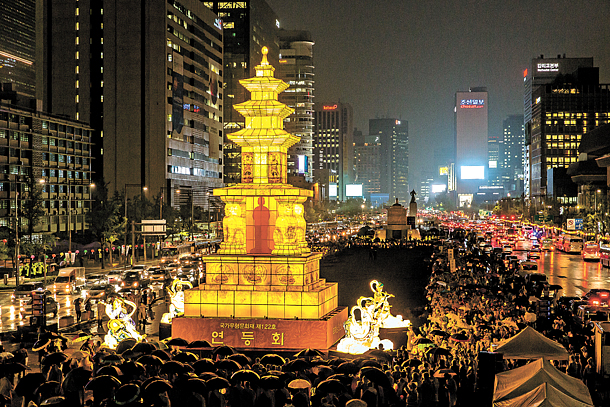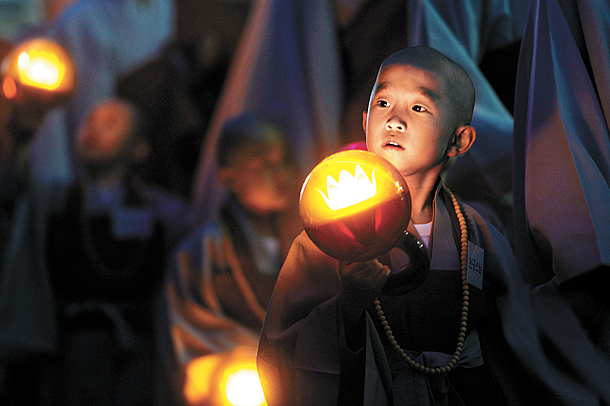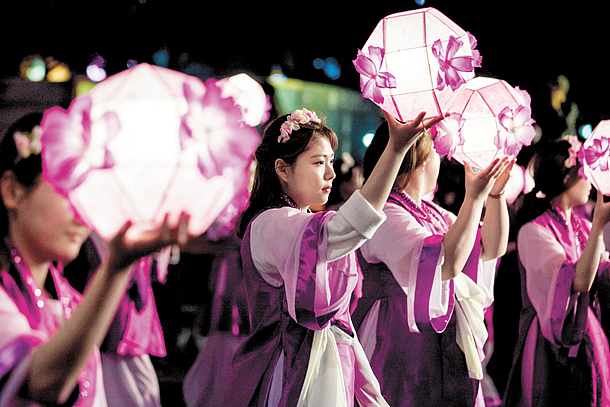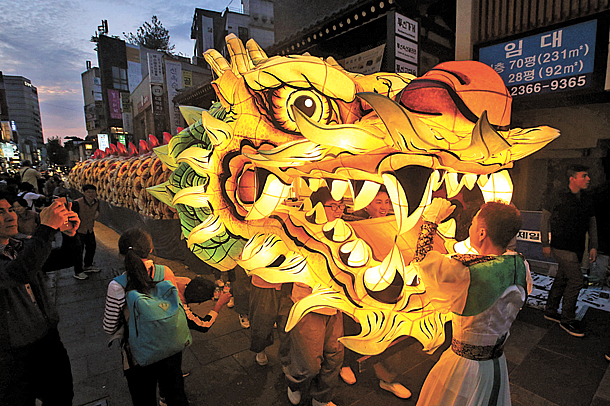Seoul gets lit for Buddha’s birthday : Streets will fill with revelers, lanterns for month-long celebration

Scenes from the lighting ceremony of the lantern replica of the stone pagoda at Mireuksa in 2016, which marks the beginning of the month-long celebrations ahead of Buddha’s birthday, held on April 8 of the Lunar calendar year. This year, the same lantern was lit on April 12, and will stay lit in Gwanghwamun Plaza until May 3. [YEONDEUNGHOE PRESERVATION COMMITTEE]
The three-day period of preliminary celebrations for Buddha’s birthday is called Yeondeunghoe, otherwise known as the Lotus Lantern Festival and will be celebrated between Dongdaemun District and Jongno District, both in central Seoul.

A young monk participating in the Yeondeunghoe looks on with a lantern in hand. For young monks who spend a long time in temples, the parade is one of the few opportunities they get to step outside. [OH SANG-MIN]
While the main theme of the Yeondeunghoe is a preliminary celebration of Buddha’s birth, the focus of the festival differs every year. The celebrations were put on hold in 2014 to show respect to the victims of the Sewol ferry tragedy, while the event in 2015 coincided with the 70th anniversary of Korea’s liberation from Japanese colonization and was held under the theme “Peaceful Mind and Harmonious World.”
Last year’s celebration was focused on “[encouraging] young people whose hopes and dreams have been compromised and are confronted by a rising unemployment rate,” the publicist for the Yeondeunghoe Preservation Committee, Hong Min-seok said.

Scenes from the lantern parade. A group of women in traditional Buddhist clothing hold up a lantern replica of a lotus with eight angles. [YEONDEUNGHOE PRESERVATION COMMITTEE]
Contrary to other celebrations which are limited only to a few days, the lotus lantern festival is month-long, while its most jubilant events are packed into the three-day period on April 28-30.
This year’s festivities began on April 12 with a lighting ceremony held in Gwanghwamun, signaling the beginning of the month-long celebration. The lantern replica of the stone pagoda at Mireuksa will stay lit in Gwanghwamun Plaza until Buddah’s birthday.

A host of colorful and extravagant lanterns move through the crowd during the lantern parade. A dragon that looks ready to breathe fire at any moment is one of the biggest lanterns of the parade. [YONHAP]
This year’s edition of the celebrations looks to be the biggest ever since recovering the festive mood after mourning the victims of the Sewol ferry disaster.
The Yeondeunghoe kicks off with the exhibition of traditional lanterns, which will be on display from April 28 to May 7. Traditional lanterns are crafted from hanji, traditional handmade Korean paper made from mulberry bark. Lanterns will be on display around Jogye Temple, Bongeun Temple and Chunggye stream. Each and every lantern is said to hold a tale of its own. High-quality hanji lanterns will light up the streets of Seoul for ten days.

The festive spirit will really kick off with the Eoulim Madang, the Buddhist Cheer Rally, with exciting music and dance held on April 29 starting at 4:30 p.m. at the athletic field of Dongguk University. Approximately 40 Lotus Lantern Performance groups, made up of over 1,000 young people, will perform for the audience. Additional temporary seats will be installed for the cheer rally this year as last year’s cheer rally saw big numbers in attendance.
The focal point of the Yeondeunghoe, the lantern parade, is held after the Buddhist Cheer Rally, at 7 p.m. It starts at Dongdaemun and continues along the streets of Jongno, namely Jongno 5-ga and Jongno 3-ga, all the way to the Jogye Temple. This year’s theme is the lantern replica of the four Buddhist instruments. The four Buddhist instruments are the bell, drum, carved wooden fish and a gong, which are each meant to control the living in heaven and earth, the living on land, the living with wings and marine creatures respectively. The four instruments hold the meaning of Buddha’s birthday and his hopes to redeem every living thing on Earth for a world without discrimination.
As the lantern parade reaches the Jonggak intersection around 9:30 p.m., the participants and the viewers of the parade gather for the Hoehyang Hanmadang, the post-parade celebration. Traditional music and dances such as the ganggangsulae, traditional Korean circle dance, will set Jonggak alight not only with the lanterns but with everyone dancing well in to the night.
Just because the day has passed, that doesn’t mean the festival is over. On the following day, more than 130 booths provide visitors a chance to experience a wide array of Korea’s traditional culture. Foreigners can experience traditional temple food, have a hands-on go at dancheong, traditional multicolored paintwork on wooden buildings, and chamseon, Zen-Buddhist meditation.
To strengthen community spirit, many programs will be dedicated to children and families. In the two stages set up at Anguk-dong and Gongpyung intersection, performances from children, international Buddhist organizations and traditional groups will showcase their abilities from 12-7 p.m. The stage in Anguk-dong will be quite international. Traditional performances by groups from Buddhist Asian countries like Nepal, Vietnam, Thailand, Sri Lanka and Mongolia will take place and foreigners will also have a chance to make lanterns that carry their own stories.
Last but not least is the grand finale of the Yeondeunghoe, the Yeondeungnori, roughly translated to playing with traditional lanterns. After all the festivities, everyone gets one last chance to bid the festival farewell with a bang, thanks to another lantern parade around the Jogye Temple area starting at 7 p.m. This final parade wishes for the prosperity of everyone and finishes the whole festival off with singing and dancing by the Lotus Lantern Performance groups. Of course, the finale doesn’t spell an end to the celebrations, as many more traditional events take place until Buddha’s Birthday on May 3.
BY KIM JUNG-KYOON [kim.jungkyoon@joongang.co.kr]










with the Korea JoongAng Daily
To write comments, please log in to one of the accounts.
Standards Board Policy (0/250자)